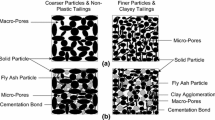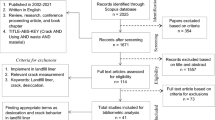Abstract
Increasing the desiccation of slurry naturally through evaporation and inhibiting of cracking with a high water content tailings slurry deposited in a large open area reduce the impacts and risks of tailings consolidation and heavy metal pollution to the environment and engineering structures. In order to investigate the influences of fly ash which is a waste byproduct on the water evaporation and cracking of tailings slurry, different amounts of fly ash (0, 10, 20, 30, 40, and 50% by weight) are mixed with the tailings slurry to produce the samples, which are then tested in the field. The cracking properties are subsequently examined based on variations in water loss. The development of cracks is quantitatively analyzed by using a digital image processing technique, which shows that the optimum amount of fly ash would accelerate evaporation and inhibit the development of desiccation cracks. The results are then plotted, and it can be observed that the samples with no fly ash and 10% fly ash have the longest crack development time. The test results indicate that the crack initiation of samples with different amounts of fly ash is in the following order: 0 > 20% > 10% > 30% > 40% > 50%. When the water content of the samples with no fly ash and 10% fly ash becomes constant, the fractal dimensions of the cracks are 1.587 and 1.577, respectively. The fractal dimensions of the samples with 20%, 30%, 40%, and 50% fly ash are 1.494, 1.456, 1.545, and 1.566, respectively. The optimum amount of fly ash is therefore 10% by weight in this study, which may effectively accelerate the natural desiccation and evaporation of tailings slurry with a high water content, and inhibit cracking. The optimum fly ash percentage thus provides a balance between improving the engineering properties of the tailings and cost.










Similar content being viewed by others
References
Angle C, Gharib S (2017) Effects of sand and flocculation on dewaterability of kaolin slurries aimed at treating mature oil sands tailings. Chem Eng Res Des 125:306–318
Badiozamani M, Askari-Nasab H (2014) Integration of reclamation and tailings management in oil sands surface mine planning. Environ Model Softw 51:45–58
Boonserm K, Sata V, Pimraksa K, Chindaprasirt P (2012) Improved geopolymerization of bottom ash by incorporating fly ash and using waste gypsum as additive. Cem Concr Compos 34:819–824
Coudert E, Paris M, Deneele D, Russo G, Tarantino A (2019) Use of alkali activated high-calcium fly ash binder for kaolin clay soil stabilisation: Physicochemical evolution. Constr Build Mater 201:539–552
Diaz E, Allouche E, Eklund S (2010) Factors affecting the suitability of fly ash as source material for geopolymers. Fuel 89(5):992–996
East D, Fernandez R (2021) Managing water to minimize risk in tailings storage facility design, construction, and operation. Mine Water Environ 40(1):36–41
Fahey M, Fujiyasu Y (1994) The influence of evaporation on the consolidation behaviour of gold tailings. Proc. 1st Int. Cong. Environ. Geotech. Bitech Publishers, Edmonton, Canada, pp. 481–486
Froehlich D (2008) Embankment dam breach parameters and their uncertainties. J Hydraul Eng 134(12):1708–1721
Fujiyasu Y, Fahey M, Newson TA (2000) Field investigation of evaporation from freshwater tailings. J Geotech Geoenviron 126(6):556–567
Hofmann T, Schuwirth N (2008) Zn and Pb release of sphalerite (ZnS)-bearing mine waste tailings. J Soil Sediment 8:433–441
Jahanshahi R, Zare M, Schneider M (2014) A metal sorption/desorption study to assess the potential efficiency of a tailings dam at the Golgohar Iron Ore Mine. Iran Mine Water Environ 33(3):228–240
Kheirkhah Gildeh H, Halliday A, Arenas A, Zhang H (2020) Tailings dam breach analysis: a review of methods, practices, and uncertainties. Mine Water Environ 40(1):128–150
Kinnunen P, Yliniemi J, Talling B, Illikainen M (2017) Rockwool waste in fly ash geopolymer composites. J Mater Cycles Waste 19:1220–1227
Kossoff D, Dubbin W, Alfredsson M, Edwards S, Macklin M, Hudson-Edwards K (2014) Mine tailings dams: characteristics, failure, environmental impacts, and remediation. Appl Geochem 51:229–245
Kumar D, Singh B (2003) The use of coal fly ash in sodic soil reclamation. Land Degrad Dev 14(3):285–299
Kumar S, Mucsi G, Kristály F, Pekker P (2017) Mechanical activation of fly ash and its influence on micro and nano-structural behaviour of resulting geopolymers. Adv Powder Technol 28(3):805–813
Lalonde R, Pinno B, Mackenzie M, Utting N (2020) Capping dewatered oil sands fluid fine tailings with salvaged reclamation soils at varying depths to grow woody plants. Can J Soil Sci 100(4):546–557
Liu M, Tan H, He X (2019) Effects of nano-SiO2 on early strength and microstructure of steam-cured high volume fly ash cement system. Constr Build Mater 194:350–359
Luo Y, Wu Y, Ma S, Zheng S, Zhang Y, Chu PK (2021) Utilization of coal fly ash in China: A mini-review on challenges and future direction. Environ Sci Pollut R 28(15):18727–18740
MacDonald T, Langridge-Monopolis J (1984) Breaching characteristics of dam failures. J Hydraul Eng 110(5):567–568
Mahedi M, Cetin B (2019) Leaching of elements from cement activated fly ash and slag amended soils. Chemosphere 235:565–574
Mastbergen D, Van Den Berg J (2003) Breaching in fine sands and the generation of sustained turbidity currents in submarine canyons. Sedimentology 50(4):625–637
Mikuni A, Komatsu R, Ikeda K (2007) Dissolution properties of some fly ash fillers applying to geopolymeric materials in alkali solution. J Mater Sci 42:2953–2957
Newson T, Fahey M (2003) Measurement of evaporation from saline tailings storages. Eng Geol 70(3–4):217–233
Qin Y, He H, Ou X, Bao T (2019) Experimental study on darkening water-rich mud tailings for accelerating desiccation. J Clean Prod 240:118235
Rico M, Benito G, Díez-Herrero A (2008) Floods from tailings dam failures. J Hazard Mater 154(1):79–87
Rico M, Benito G, Salgueiro A, Diez-herrero A, Pereira H (2007) Reported tailings dam failures: a review of the European incidents in the worldwide context. J Hazard Mater 152:846–852
Riehl A, Elsass F, Duplay J, Huber F, Trautmann M (2010) Changes in soil properties in a fluvisol (calcaric) amended with coal fly ash. Geoderma 155(1–2):67–74
Schmocker L (2009) The failure of embankment dams due to overtopping. J Hydraul Res 47(2):288–288
Shehata N, Sayed E, Abdelkareem M (2021) Recent progress in environmentally friendly geopolymers: A review. Sci Total Environ 762:143166
Simms P, Grabinsky M, Zhan G (2007) Modelling evaporation of paste tailings from the Bulyanhulu mine. Can Geotech J 44(12):1417–1432
Simms P, Soleimani S, Mizani S, Daliri F, Dunmola A, Rozina E, Innocent-Bernard T (2019) Cracking, salinity and evaporation in mesoscale experiments on three types of tailings. Environ Geotech 6(1):3–17
Sutcu M, Erdogmus E, Gencel O, Gholampour A, Atan E, Ozbakkaloglu T (2019) Recycling of bottom ash and fly ash wastes in eco-friendly clay brick production. J Clean Prod 233:753–764
Waugh W, Smith G, Bergman-Tabbert D, Metzler D (2001) Evolution of cover systems for the uranium mill tailings remedial action project, USA. Mine Water Environ 20(4):190–197
Yang B, Li D, Yuan S, Jin L (2021) Role of biochar from corn straw in influencing crack propagation and evaporation in sodic soils. Catena 204:105457
Yang B, Liu J, Zhao X, Zheng S (2021b) Evaporation and cracked soda soil improved by fly ash from recycled materials. Land Degrad Dev 32(9):2823–2832
Yang B, Xu K, Zhang Z (2020) Mitigating evaporation and desiccation cracks in soil with the sustainable material biochar. Soil Sci Soc Am J 84(2):461–471
Yang B, Yuan J (2019) Influence of soda content on desiccation cracks in clayey soils. Soil Sci Soc Am J 83(4):1054–1061
Yang B, Yuan S, Liang Y, Liu J (2021c) Investigation of overburden failure characteristics due to combined mining: case study, Henan Province. China Environ Earth Sci 80:143
Yao C, Wu L, Yang J, Xiao L, Liu X, Jiang Q, Zhou C (2020) Influences of tailings particle size on overtopping tailings dam failures. Mine Water Environ 40(1):174–188
Yuan B, Li Z, Chen Y, Ni H, Zhao Z, Chen W, Zhao J (2021) Mechanical and microstructural properties of recycling granite residual soil reinforced with glass fiber and liquid-modified polyvinyl alcohol polymer. Chemosphere 268:131652
Yuan B, Li Z, Su Z, Luo Q, Chen M, Zhao Z (2021b) Sensitivity of multistage fill slope based on finite element model. Adv Civ Eng 2021:6622936
Yuan B, Li Z, Zhao Z, Ni H, Su Z, Li Z (2021c) Experimental study of displacement field of layered soils surrounding laterally loaded pile based on Transparent Soil. J Soil Sediment 21(9):3072–3083
Yuan S, Yang B, Liu J, Cao B (2021d) Influence of fibers on desiccation cracks in sodic soil. B Eng Geol Environ 80(4):3207–3216
Zhang D, Thundat T, Narain R (2017) Flocculation and dewatering of mature fines tailings using temperature responsive cationic polymers. Langmuir 33:5900–5909
Acknowledgements
We would also like acknowledge the anonymous reviewers for their invaluable comments and suggestions that led to significant improvements in the paper.
Funding
The authors received financial support from the Education Department Henan Province: Key Scientific Research Project of Colleges and Universities in Henan Province (CN) under grant no. 21A410003.
Author information
Authors and Affiliations
Corresponding author
Ethics declarations
Conflict of interest
The authors declare that they have no competing interests.
Additional information
Responsible Editor: Amjad Kallel
Rights and permissions
About this article
Cite this article
Yuan, S., Duan, W. & Liu, Y. Effects of recycled fly ash on desiccation cracking of mine tailings with high water content. Arab J Geosci 14, 2828 (2021). https://doi.org/10.1007/s12517-021-09225-2
Received:
Accepted:
Published:
DOI: https://doi.org/10.1007/s12517-021-09225-2




